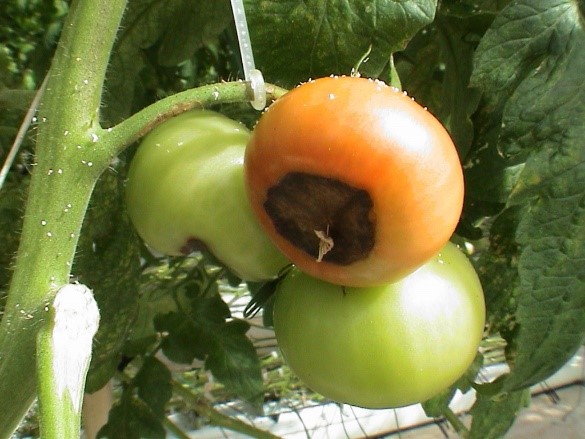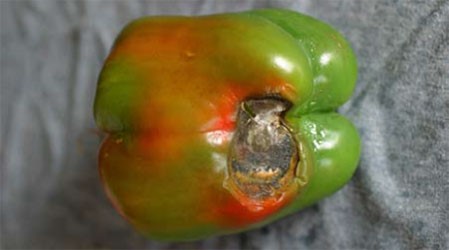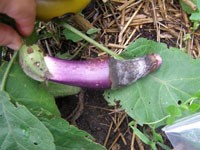Tomato Blossom-End Rot
go.ncsu.edu/readext?708663
en Español / em Português
El inglés es el idioma de control de esta página. En la medida en que haya algún conflicto entre la traducción al inglés y la traducción, el inglés prevalece.
Al hacer clic en el enlace de traducción se activa un servicio de traducción gratuito para convertir la página al español. Al igual que con cualquier traducción por Internet, la conversión no es sensible al contexto y puede que no traduzca el texto en su significado original. NC State Extension no garantiza la exactitud del texto traducido. Por favor, tenga en cuenta que algunas aplicaciones y/o servicios pueden no funcionar como se espera cuando se traducen.
Português
Inglês é o idioma de controle desta página. Na medida que haja algum conflito entre o texto original em Inglês e a tradução, o Inglês prevalece.
Ao clicar no link de tradução, um serviço gratuito de tradução será ativado para converter a página para o Português. Como em qualquer tradução pela internet, a conversão não é sensivel ao contexto e pode não ocorrer a tradução para o significado orginal. O serviço de Extensão da Carolina do Norte (NC State Extension) não garante a exatidão do texto traduzido. Por favor, observe que algumas funções ou serviços podem não funcionar como esperado após a tradução.
English
English is the controlling language of this page. To the extent there is any conflict between the English text and the translation, English controls.
Clicking on the translation link activates a free translation service to convert the page to Spanish. As with any Internet translation, the conversion is not context-sensitive and may not translate the text to its original meaning. NC State Extension does not guarantee the accuracy of the translated text. Please note that some applications and/or services may not function as expected when translated.
Collapse ▲New and experienced gardeners find challenges with growing tomatoes, especially here in the South. The high humidity we experience each summer works against the gardener. Plant diseases thrive on this environment and it sometimes leaves less than desirable outcomes. One problem that shows up each year is blossom-end rot. It looks like a disease but is a physiological disorder. It is caused by a lack of calcium. Generally, this disorder is most severe following extremes in soil moisture (too wet or too dry).
Tomatoes with this order will develop a brown or tan decayed area on the end that is not attached to the stem. This is the blossom end of the tomato, thus the name of the disorder, blossom-end rot. The name is not very creative, just one that goes straight to the point. The decayed area starts small but grows as the fruit grows. This can also be seen in peppers and eggplants.
As ugly as this disorder makes the fruit, it is easy to prevent.
- Lime soil to pH 6.5 to 6.7 – Home gardens not limed in the past 2 to 3 years will need 2 cups of lime fore each plant. The lime should be worked into the soil 12 inches deep. To determine the exact about of lime, send a soil sample to the Agronomic Division of the North Carolina Department of Agriculture & Consumer Services, for analysis and recommendations. Soil sampling kits are available at our office.
- Fertilize properly – Too much fertilizer at one time can result in blossom-end rot. Following soil test recommendations is the best way to insure proper fertilization. If there is no soil test, apply 4 pints of 10-10-10 per 100 feet of row, and thoroughly work it into the top 8 inches of soil.
- Mulch plants – Use straw, pine straw, decomposed sawdust, ground/decomposed corn cobs, plastic, or newspapers. Mulches conserve moisture and reduce blossom-end rot.
- Irrigate when necessary – Tomato plants require about 1.5 inches of water per week during fruiting. This amount of water should be supplied by rain or irrigation. Extreme fluctuations in soil moisture result in a greater incidence of blossom-end rot.
- Spray calcium – The plants may be sprayed with a calcium solution using calcium nitrate or calcium chloride at 4 level tablespoons per gallon of water. This spray should be applied 2 to 3 times a week, beginning at the time the second fruit clusters bloom. These materials can be mixed with spray that is used for control of foliar diseases. Chelated calcium solutions also provide an excellent source of calcium. When using these chelates, follow label directions. Several foliar spray materials containing calcium are available and all work well for tomatoes.







